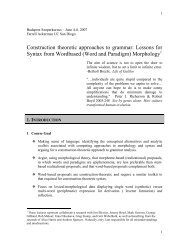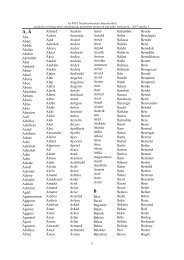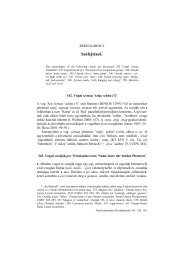Nyelvtudományi közlemények 91. kötet (1990)
Nyelvtudományi közlemények 91. kötet (1990)
Nyelvtudományi közlemények 91. kötet (1990)
Sie wollen auch ein ePaper? Erhöhen Sie die Reichweite Ihrer Titel.
YUMPU macht aus Druck-PDFs automatisch weboptimierte ePaper, die Google liebt.
AN OBSTINATE ETYMOLOGICAL DIVERSITY 115<br />
ently of the same opinion, since he does not list any Cheremis forms under<br />
the cognâtes of Finnish joki. Still, the etymological diversity persists. The<br />
authorities on the subject, SKES and MSzFE both give the Cheremis form<br />
joya/joyan as a cognate to joki and jó provided with a question mark and a<br />
référence to possible Chuvash connection. Péter Hajdú (1976. 98) has contradictory<br />
statements: Cheremis joyan is not mentioned among the cognâtes<br />
of Hungárián jó, but is presented as an example of the Finno-Ugric genitive<br />
(joyaijoyan - 118) — of course it could be maintained that the genitive<br />
is Finno-Ugric although the word stem is not. Kaisa Häkkinen in a word<br />
list included in her dissertation (1983) gives Eastern (should be Western)<br />
Cheremis joya as a cognate of Finnish joki (287) although she mentions<br />
beforehand that the connection is open to dispute (269).<br />
Thus there are three différent opinions: the Cheremis word stem joyrepresents<br />
common Finno-Ugric stock; it is an Altaic (Chuvash) borrowing;<br />
it is Finno-Ugric but open to doubt. On my part I would say that the case<br />
is clear: the Cheremis joy- is a Chuvash loan élément in the language, as a<br />
base for a noun as well as a base for a verb. That has been shown adequately<br />
from the Altaic point of view; I will endeavour to give a summary of the<br />
Finno-Ugric évidence.<br />
A. Phonological évidence. The Finno-Ugric intervocalic *-k- is represented<br />
in the Cheremis language by 0 or j (Collinder 1960. 77). This is<br />
supported by several etymologies:<br />
Finnish ikä 'âge' ~ Cheremis i, ij, iv 'year' (Lappish jakkeijage, Mordvin<br />
ye),<br />
Finnish luku 'number' ~ Cheremis lu '10' (Lappish lokkâdogâ, Mordvin lovo,<br />
Hungárián olvas),<br />
Finnish oike-a' 'right' ~ Cheremis ßij-as 'straight' (Mordvin vijede),<br />
Finnish säkä 'silure (fish)' ~ Cheremis si, sij(yol) id.,<br />
Finnish väki 'strenght' ~ Cheremis ßi, ßij id. (Mordvin vij). On the other<br />
hand, except for this dubious joya there exists no example of the Finno-<br />
Ugric intervocalic *-k- occurring as -y- in Cheremis. The correspondence<br />
of Finnish koko 'size' ~ Cheremis koyojkuyu 'big' presented by Wichmann<br />
(1923. 63) has been rejected by later scholars. (It should be remember<br />
that both Finnish and Cheremis have the pronominal stem kujko, and the<br />
word for wholeness, size could be a reduplication of this stem.) Accordingly,<br />
phonological évidence speaks against the Cheremis stem joya- being<br />
of Finno-Ugric origin.<br />
B. Morphological évidence. The form joya could, of course, stand for<br />
a nominative and the form joyan for a genitive case form. The trouble is<br />
that this kind of a paradigm does not exist. The Western dialect KB (Kozmodemiansk<br />
or Mountain Cheremis) recognizes the form joya, the other<br />
Nyelvtudományi Közlemények <strong>91.</strong> <strong>1990</strong>.


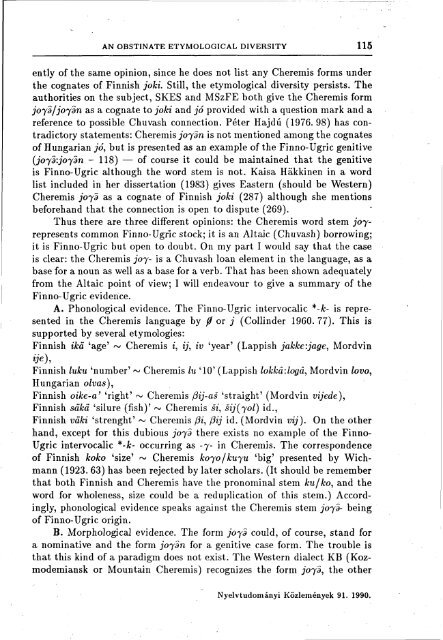

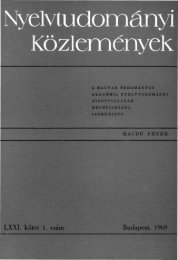

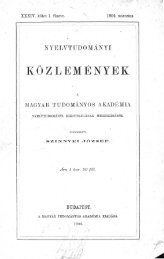
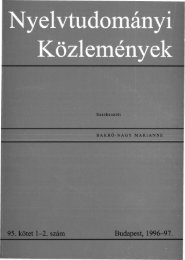
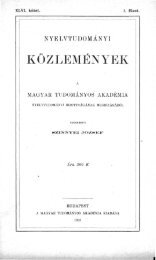
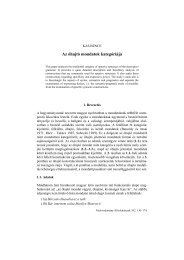
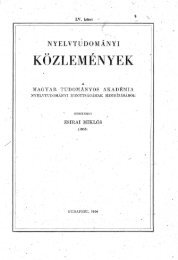
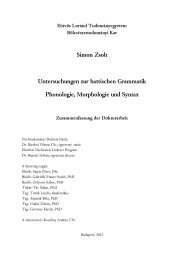
![Gósy Mária: A [p, t, k] mássalhangzók zöngekezdési ideje Bevezetés ...](https://img.yumpu.com/15682849/1/190x245/gosy-maria-a-p-t-k-massalhangzok-zongekezdesi-ideje-bevezetes-.jpg?quality=85)

